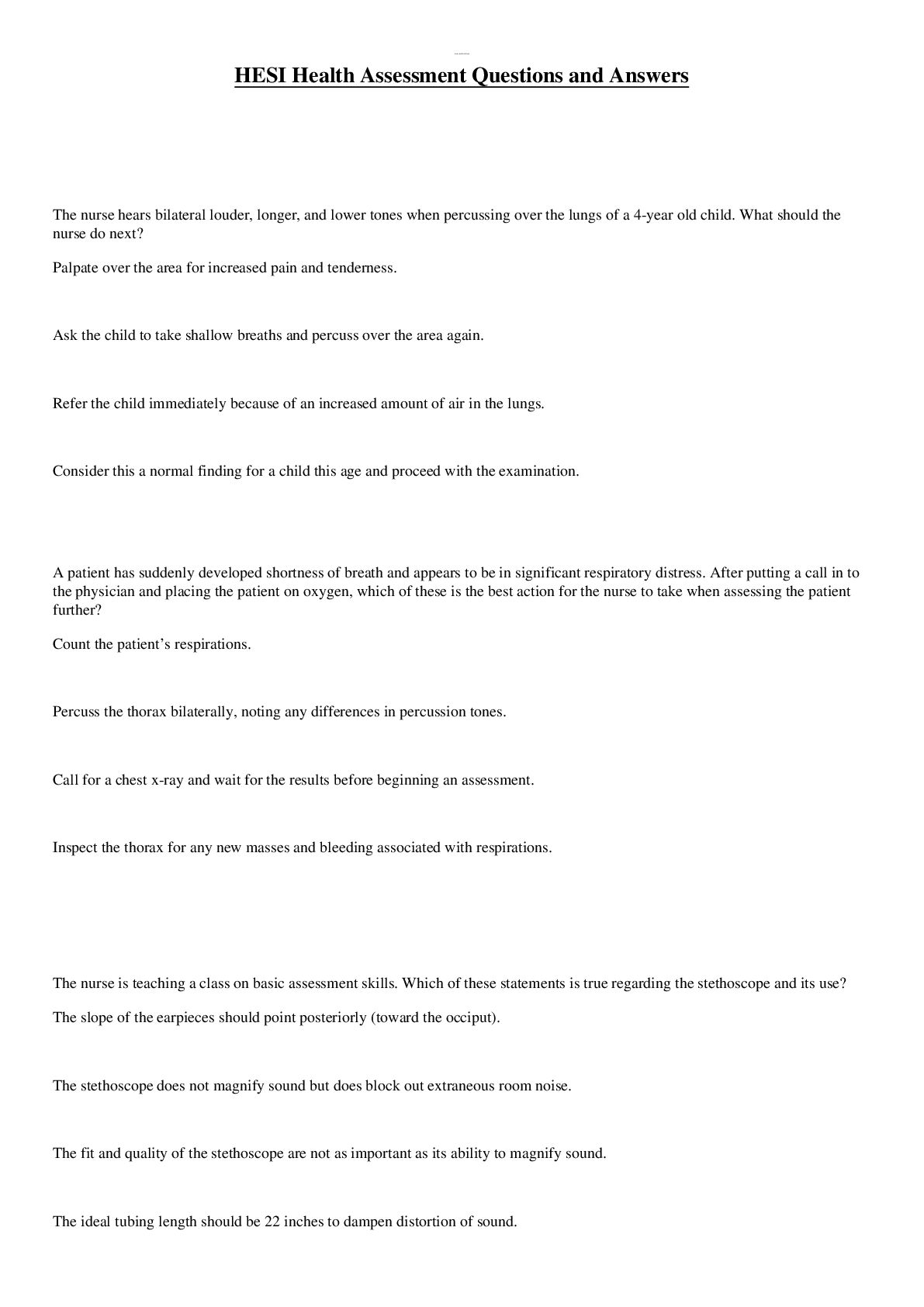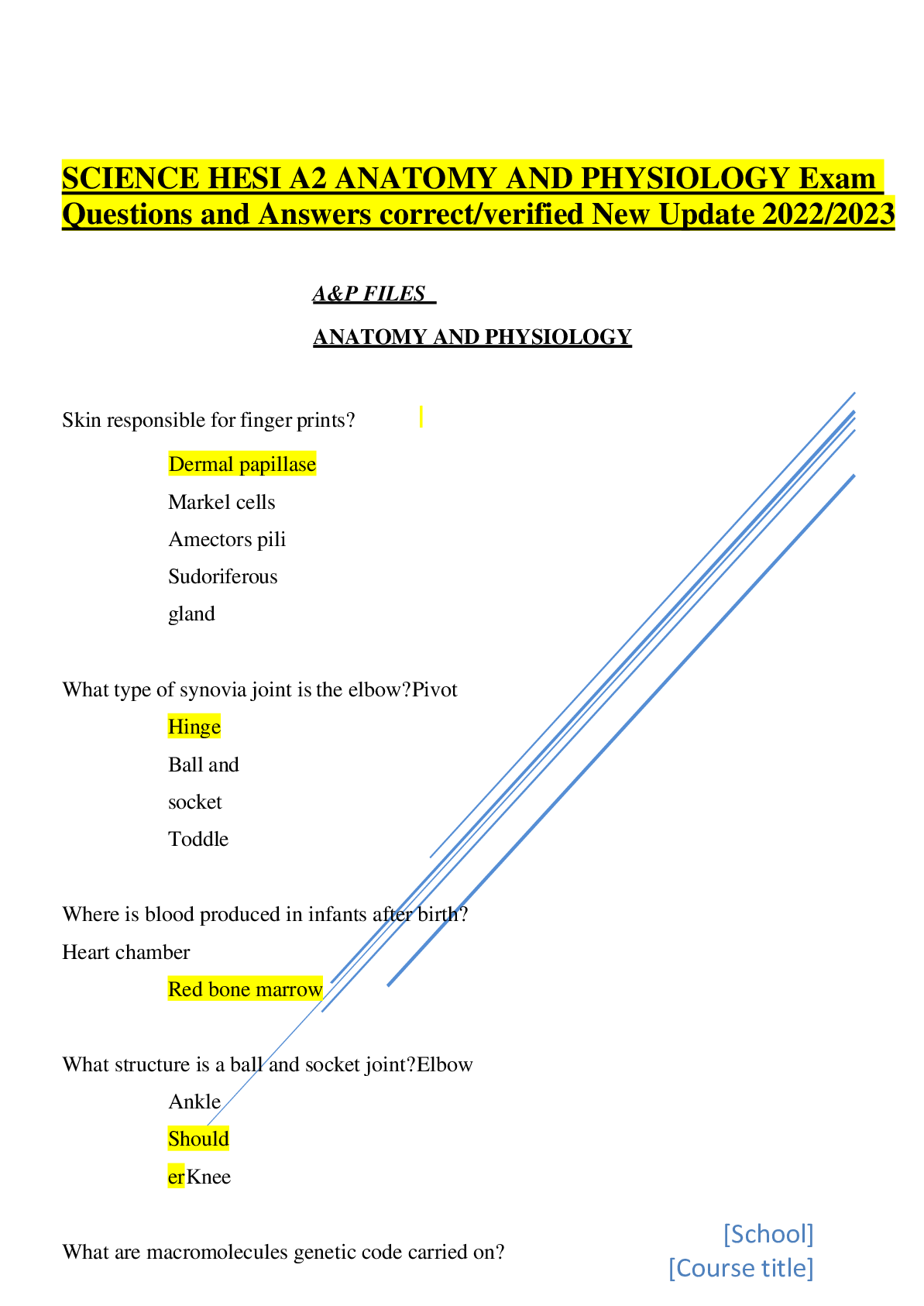HESI FUNDAMENTALS PRACTICE EXAM 2022 Questions and Answers
Document Content and Description Below
The nurse observes that a male client has removed the covering from an ice park applied to his knee. What action should the nurse take first? A. Observe the appearance of the skin under the ice pack... . B. Instruct the client regarding the need for the covering. C. Reapply the covering after filling with fresh ice. D. Ask the client how long the ice was applied to the skin. - ANSWER Observe the appearance of the skin under the ice pack (The first action taken by the nurse should be to assess the skin for any possible thermal injury. If no injury to the skin has occurred, the nurse can take the other actions.) The nurse mixes 50 mg of Nipride in 250 mL of D5W and plans to administer the solution at a rate of 5 mcg/kg/min to a client weighting 182 lbs. Using a drip factor of 60 gtt/mL, how many drops per minute should the client receive? - ANSWER 124 gtt/min The healthcare provider prescribes an IV infusion of 1000 ml of Ringer's Lactate w/ 30 units of Pitocin to run in over 4 hours for a client who has just delivered a 10 pound infant by cesarean section. The tubing has been changed to a 20 gtt/ml administration set. The nurse plans to set the flow rate at how many gtt/min? - ANSWER 83 gtt/min Which assessment data provides the most accurate determination of proper placement of a nasogastric tube? - ANSWER Examining a chest x-ray obtained after the tubing was inserted Three days following a surgery, a male client observes his colostomy for the first time. He becomes quite upset and tells the nurse that it is much bigger than he expected. What is the best response by the nurse? A. Reassure the client that he will become accustomed to the stoma appearance in time. B. Instruct the client that the stoma will become much smaller when the initial swelling diminishes. C. Offer to contact a member of the local ostomy support group to help him with his concerns. D. Encourage the client to handle the stoma equipment to gain confidence with the procedure. - ANSWER B. Instruct the client that the stoma will become smaller when the initial swelling diminishes (Postoperative swelling causes enlargement of the stoma. The nurse can teach the client that the stoma will become smaller when swelling is diminished (B). This will help reduce the client's anxiety and promote acceptance of the colostomy. (A) does not provide helpful teaching or support. (C) is a useful action, and may be taken after the nurse provides pertinent teaching. The client is not yet demonstrating readiness to learn colostomy care. (D) A female client with a nasogastric tube attached to low suction states that she is nauseated. The nurse assesses that there has been no drainage through the nasogastric tube in the last two hours. What action should the nurse take first? A. Irrigate the nasogastric tube with sterile normal saline. B. Reposition the client on her side. C. Advance the nasogastric tube an additional five centimeters. D. Administer an intravenous antiemetic prescribed for PRN use. - ANSWER B. Reposition the client on her side. (The immediate priority is to determine if the tube is functioning correctly, which would then relieve the client's nausea. The least invasive intervention (B) should be attempted first, followed by (A and C), unless either of these interventions is contraindicated. If these measures are unsuccessful, the client may require an antiemetic (D)) A hospitalized male client is receiving nasogastric tube feedings via a small-bore tube and a continuous pump infusion. He reports that he had a bad bout of severe coughing a few minutes ago, but feels fine now. What action is best for the nurse to take? A. Record the coughing incident. No further action is required at this time. B. Stop the feeding, explain to the family why it is being stopped, and notify the HCP. C. After clearing the tube with 30 ml of air, check the pH of fluid withdrawn from the tube. D. Inject 30 ml of air into the tube while auscultating the epigastrium for gurgling. - ANSWER C. After clearing the tube with 30 ml of air, check the pH of fluid withdrawn from the tube. A male client tells the nurse that he does not know where he is or what year it is. What data should the nurse document that is most accurate? A. demonstrates loss of remote memory B. exhibits expressive dysphasia C. has a diminished attention span D. is disoriented to place and time - ANSWER D. is disoriented to place and time (The client is exhibiting disorientation (D). (A) refers to memory of the distant past. The client is able to express himself without difficulty (B), and does not demonstrate diminished attention span. (C). A client with chronic kidney disease (CKD) selects a scrambled egg for his breakfast. What action should the nurse take? A. Commend the client for selecting a high biologic value protein. B. Remind the client that protein in the diet should be avoided. C. Suggest that the client also select orange juice, to promote absorption. D. Encourage the client to attend classes on dietary management of CKD. - ANSWER A. Commend the client for selecting a high biologic value protein. (Foods such as eggs and milk (A) are high biologic proteins which are allowed because they are complete proteins and supply the essential amino acids that are necessary for growth and cell repair. Orange juice is rich in potassium and should not be encouraged. The client has made a good diet choice so (D) is not necessary.) When assisting an 82 year old client to ambulate, it is important for the nurse to realize that the center of gravity for an elderly person is the-- - ANSWER Upper torso (The center of gravity for adults is the hips. However, as the person grows older, a stooped posture is common because of the changes from osteoporosis and normal bone degeneration, and the knees, hips, and elbows flex. This stooped posture results in the upper torso becoming the center of gravity for older persons.) In developing a plan of care for a client with dementia, the nurse should remember that confusion in the elderly A. is to be expected, and progresses with age B. often follows relocation to new surroundings C. is a result of irreversible brain pathology D. can be prevented with adequate sleep - ANSWER B. often follows relocation to new surroundings (Relocation (B) often results in confusion among elderly clients-- moving is stressful for anyone. (A) is stereotypical judgement. Stress in the elderly often manifests itself as confusion, so (C) is wrong. Adequate sleep is not a prevention (D) for confusion.) A postoperative client will need to perform daily dressing changes after discharge. Which outcome statement best demonstrates the client's readiness to manage his wound care after discharge? The client A. asks relevant questions regarding the dressing change B. states he will be able to complete the wound care regimen C. demonstrates the wound care procedure correctly D. has all the necessary supplies for wound care - ANSWER C. demonstrates the wound care procedure correctly (A return demonstration of a procedure (C) provides an objective assessment of the client's ability to perform a task, while (A and B) are subjective measures. (D) is important, but is less of a priority than the the nurse's assessment of the client's ability to complete wound care.) A client who is 5 '5" tall and weighs 200 pounds is scheduled for surgery the next day. What question is most important for the nurse to include during the preoperative assessment? A. What is your daily calorie consumption? B. What vitamin and mineral supplements do you take?" C. "Do you feel that you are overweight?" D. "Will a clear liquid diet be okay after surgery?" - ANSWER B. "What vitamin and mineral supplements do you take?" (Vitamin and mineral supplements (B) may impact medications used during the operative period. (A and C) are appropriate questions for long-term dietary counseling. The nature of the surgery and anesthesia will determine the need for a clear liquid diet (D), rather than the client's preference.) During the initial morning assessment, a male client denies dysuria but reports that his urine appears dark amber. Which intervention should the nurse implement? A. Provide additional coffee on the client's breakfast tray. B. Exchange the client's grape juice for cranberry juice. C. Bring the client additional fruit at mid-morning. D. Encourage additional oral intake of juices and water. - ANSWER D. Encourage additional oral intake of juices and water. Which intervention is most important for the nurse to implement for a male client who is experiencing urinary retention? A. Apply a condom catheter B. Apply a skin protectant C. Encourage increased fluid intake D. Assess for bladder distention - ANSWER D. Assess the bladder for distention (Urinary retention is the inability to void all urine collected in the bladder, which leads to uncomfortable bladder distention (D). (A and B) are useful actions to protect the skin of a client with urinary incontinence. (C) may worsen the bladder distention.) A client with acute hemorrhagic anemia is to receive four units of packed RBCs as rapidly as possible. Which intervention is most important for the nurse to implement? A. Obtain the pre-transfusion hemoglobin level. B. Prime the tubing and prepare a blood pump set-up C. Monitor vital signs q 15 min for the first hour. D. Ensure the accuracy of the blood type match. - ANSWER D. Ensure the accuracy of the blood type match. (ALL interventions should be implemented prior to administering blood, but (D) has the highest priority. Any time blood is administered the nurse should ensure the accuracy of the blood type match in order to prevent a possible hemolytic reaction.) A male client being discharged with a prescription for the bronchodilator theophylline tells the nurse that he understands he is to take three doses of the medication each day. Since, at the time of discharge, time-released capsules are not available, which dosing schedule should the nurse advise the client to follow? - ANSWER 8 AM, 4 PM, and midnight (Theophylline should be administered on a regular around the clock schedule to provide the best bronchodilating effect and reduce the potential for adverse effects.) A client is to receive 10 mEq of KCl diluted in 250 mL of normal saline over 4 hours. At what rate should the nurse set the client's intravenous infusion pump? - ANSWER 63 mL/hr When evaluating a client's plan of care, the nurse determines that a desire outcome was not achieved. Which action should the nurse implement first? A. Establish a new nursing diagnosis. B. Note which actions were not implemented. C. Add additional nursing orders to the plan. D. Collaborate with the HCP to make changes. - ANSWER B. Note which actions were not implemented. (First, the nurse should review which actions in the original plan were not implemented (B) in order to determine why the original plan did not produce the desired outcome. Appropriate revisions can then be made, which may include revising the expected outcome, or identifying a new nursing diagnosis (A). (C) may be needed if the nursing actions were unsuccessful, or were unable to be implemented. (D) other members of the healthcare team may be necessary to collaborate changes once the nurse determines why the original plan did not produce the desired outcome. Which snack food is best for the nurse to provide a client with myasthenia graves who is at risk for altered nutritional status? A. chocolate pudding B. graham crackers C. sugar free gelatin D. apple slices - ANSWER A. chocolate pudding (The client with myasthenia graves is at high risk for altered nutrition because of fatigue and muscle weakness resulting in dysphagia. Snacks that are semisolid, such as pudding (A) are easy to swallow and require minimal chewing effort, and provide calories and protein. (C) does not provide any nutritional value. (B and D) require energy to chew and are more difficult to swallow than pudding.) The nurse is instructing a client with high cholesterol about diet and life style modification. What comment from the client indicates that the teaching has been effective? A. "If I exercise at least two times weekly for one hour, I will lower my cholesterol." B. "I need to avoid eating proteins, including red meat." C. "I will limit my intake of beef to 4 ounces per week." D. "My blood level of low density lipoproteins needs to increase." - ANSWER C. "I will limit my intake of beef to 4 ounces per week." (Limiting saturated fat from animal food sources to no more than 4 ounces per week (C) is an important diet modification for lowering cholesterol. To be effective in reducing cholesterol, the client should exercise 30 minutes per day, or at least 4 to 6 times per week (A). Red meat and all proteins do not need to be eliminated (B) to lower cholesterol, but should be restricted to lean cuts of red meat and smaller portions (2-ounce servings). The low density lipoproteins (D) need to decrease rather than increase.) An obese male client discusses with the nurse his plans to begin long-term weight loss regimen. In addition to dietary changes, he plans to begin an intensive aerobic exercise program 3 to 4 times a week and to take stress management classes. After praising the client for his decision, which instruction is most important for the nurse to provide? A. "Be sure to have a complete physical examination before beginning your planned exercise program." B. "Be careful that the exercise program doesn't simply add to your stress level, making you want to eat more." C. "Increased exercise helps to reduce stress, so you may not need to spend money on a stress management class." D. "Make sure to monitor your weight loss regularly to provide a sense of accomplishment and motivation." - ANSWER A. "Be sure to have a complete physical examination before your planned exercise program." (The most important teaching is (A), so that the client will not begin a dangerous level of exercise when he is not sufficiently fit. This might result in chest pain, a heart attack, or stroke. (B, C, and D) are important instructions, but are of less priority than (A). ) The nurse is teaching a client proper use of an inhaler. When should the client administer the inhaler-delivered medication to demonstrate correct use of the inhaler? A. Immediately after exhalation. B. During the inhalation C. At the end of three inhalers D. Immediately after inhalation - ANSWER B. During the inhalation. (The client should be instructed to deliver the medication during the last part of inhalation (B). After the medication is delivered, the client should remove the mouthpiece, keeping his/her lips closed and breath held for several seconds to allow for distribution of the medication. The client should not deliver the dose as started in (A or D), and should deliver no more than two inhalations at a time (C).) An IV infusion terbutaline sulfate 5 mg in 500 mL of D5W, infusing at a rate of 30 mcg/min, is prescribed for a client in premature labor. How many ml/hr should the nurse set the infusion pump? - ANSWER 180 The healthcare provider prescribes the diuretic metolazone (Zaroxolyn) 7.5 mg PO. Zaroxoltn is available in 5 mg tablets. How much should the nurse plan to administer? - ANSWER 1 1/2 tablets The healthcare provider prescribes furosemide (Lasix) 15 mg IV stat. On hand is Lasix 20 mg/2ml. How many millileters should the nurse administer? - ANSWER 1.5 mL Heparin 20,000 units in 500 mL D5W at 50 mL/hour has been infusing for 5.5 hours. How much heparin has the client received? - ANSWER 11,000 units The nurse is caring for a client who is receiving 24-hour total parenteral nutrition (TPN) via a central line at 54 mL/hr. When initially assessing the client, the nurse notes that the TPN solution has run out and the next TPN solution is not available. What immediate action should the nurse take? A. Infuse normal saline at a keep vein open rate. B. Discontinue the IV and flush the port with heparin. C. Infuse 10% dextrose and water at 54 mL/hour. D. Obtain a stat blood glucose level and notify the HCP. - ANSWER C. Infuse 10% dextrose and water at 54 mL/hour. (TPN is discontinued gradually to allow the client to adjust decreased levels of glucose. Administering 10% dextrose in water at the prescribed rate (C) will keep the client from experiencing hypoglycemia until the next TPN solution is available. The client could experience a hypoglycemic reaction if the current level of glucose (A) is not maintained or if the TPN is discontinued abruptly (B). There is no reason to obtain a stat blood-glucose level (D) and the HCP cannot do anything about this situation.) Examination of a client complaining of itching on his right arm reveals a rash made up of multiple flat areas of redness ranging from pinpoint to 0.5 cm in diameter. How should the nurse record this finding? A. Multiple vesicular areas surrounded by redness, ranging in size from 1 mm to 0.5 cm. B. Localized red rash comprised of flat areas, pinpoint to 0.5 cm in diameter. C. Several areas of red, papular lesions from pinpoint to 0.5 cm in size. D. Localized petechial areas, ranging in size from pinpoint to 0.5 cm in diameter. - ANSWER B. Localized red rash comprised of flat areas, pinpoint to 0.5 cm in diameter. (Macules are localized flat skin discolorations less than 1 cm in diameter. However, when recording such a finding the nurse should describe the appearance (B) rather than simply naming the condition. (A) identifies vesicles-- fluid filled blisters--an incorrect description given the symptoms listed. (C) identifies papule-- solid elevated lesions, again not correctly identifying the symptoms. (D) identifies petechiae-- pinpoint red to purple skin discolorations that do not itch, again an incorrect identification.) At the time of the first dressing change, the client refuses to look at her mastectomy incision. The nurse tells the client that the incision is healing well, but the client refuses to talk about it. What would be an appropriate response to this client's silence? A. "It is normal to feel angry and depressed, but the sooner you deal with this surgery, the better you will feel." B. "Looking at your incision can be frightening, but facing this fear is a necessary part of your recovery." C. "It is OK if you don't want to talk about your surgery. I will be available when you are ready." D. "I will ask a woman who has had a mastectomy to come by and share her experiences with you." - ANSWER C. "It is OK if you don't want to talk about your surgery. I will be available when you are ready." ( (C) displays sensitivity and understanding without judging the client. (A) is judgmental in that it is telling the client how she feels and is also insensitive. (B) would give the client a chance to talk, but is also demanding and demeaning. (D) displays a positive action, but, because the nurse's personal support if not offered, this response could be interpreted as dismissing the client and avoiding the problem.) The nurse is evaluating a client learning about a low-sodium diet. Selection of which meal would indicate to the nurse that this client understands the dietary restrictions? - ANSWER Skim milk, turkey salad, roll, and vanilla ice cream The nurse prepares a 1000 mL IV of 5% dextrose and water to be infused over 8 hours. The infusion set delivers 10 drops per milliliter . The nurse should regulate the IV to administer approximately how many drops per minute? - ANSWER 21 An elderly male client who is unresponsive following a cerebral vascular accident (CVA) is receiving bolus enteral feedings through a gastronomy tube. What is the best client position for administration of the bolus tube feedings? A. Prone B. Fowler's C. Sim's D. Supine - ANSWER B. Fowler's (The client should be positioned in a semi-setting (B) position during feeding to decrease occurrence of aspiration. A gastronomy tube, known as PEG tube, due to placement by a percutaneous endoscopic gastronomy procedure, is inserted directly into the stomach through an incision in the abdomen for long-term administration of nutrition and hydration in the debilitated client. In (A and/or C), the client is placed on the abdomen, an unsafe position for feeding. Placing the client in (D) increases the risk for aspiration.) Which action is the most important to implement when donning sterile gloves? A. Maintain thumb at a ninety degree angle. B. Hold hands with fingers down while gloving. C. Keep gloved hands above the elbows. D. Put the glove on the dominant hand first. - ANSWER C. Keep gloved hands above the elbows. (Gloved hands held below waist level are considered unsterile (C). (A and B) are not essential to maintaining asepsis. While it may be helpful to put the glove on the dominant hand first, it is not necessary to ensure asepsis (D).) The nurse is teaching a client with numerous allergies how to avoid allergens. Which instruction should be included in this teaching plan? A. Avoid any types of sprays, powders, and perfumes. B. Wearing a mask while cleaning will not help to avoid allergens. C. Purchase any type of clothing, but be sure it is washed before wearing it. D. Pollen count is related to hay fever, not to allergens. - ANSWER A. Avoid any type of sprays, powders, and perfumes. A 73-year-old female client had a hemiarthroplasty of the left hip yesterday due to a fracture resulting from a fall. In reviewing hip precautions with the client, which instruction should the nurse include in this client's teaching plan? A. "In 8 weeks you will be able to bend at the waist to reach items on the floor." B. "Place a pillow between your knees while lying in bed to prevent hip dislocation." C. "It is safe to use a walker to get out of bed, but you need assistance when walking." D. "Take pain medication 30 minutes after your physical therapy sessions." - ANSWER B. "Place a pillow between your knees while lying in bed to prevent hip dislocation." (The client's affected hip joint following a hemiarthroplasty (partial hip replacement) is at risk of dislocation for 6 months to a year following the procedure. Hip precautions to prevent dislocation include placing a pillow between the knees to maintain abduction of the hips (B). Clients should be instructed to avoid bending at the waist (A), to seek assistance for both standing and walking until they are stable on a walker or cane (C), and to take pain medication 20 to 30 minutes prior to physical therapy sessions, rather than waiting until the pain level is high after their therapy.) The nurse is performing nasotracheal suctioning. After suctioning the client's trachea for fifteen seconds, large amounts of thick yellow secretions return. What action should the nurse implement next? A. Encourage the client to cough to help loosen secretions. B. Advise the client to increase the intake of oral fluids. C. Rotate the suction catheter to obtain any remaining secretions. D. Re-oxygenate the client before attempting to suction again. - ANSWER D. Re-oxygenate the client before attempting to suction again. A client's infusion of normal saline infiltrated earlier today, and approximately 500 mL of saline infused into the subcutaneous tissue. The client is now complaining of excruciating arm pain and demanding stronger pain medications. What initial action is most important for the nurse to take? A. Ask about any past history of drug abuse or addiction. B. Measure the pulse volume and capillary refill distal to the infiltration. C. Compress the infiltrated tissue to measure the degree of edema. D. Evaluate the extent of ecchymosis over the forearm area. - ANSWER B. Measure the pulse volume and capillary refill distal to the infiltration. (Pain and diminished pulse volume (B) are signs of compartment syndrome, which can progress to complete loss of the peripheral pulse in the extremity. Compartment syndrome occurs when external pressure (usually from a cast) or internal pressure (usually form subcutaneous infused fluid), exceeds capillary perfusion pressure resulting in decreased blood flow to the extremity. (A) should not be pursued until physical causes of the pain are ruled out. (C) is less of a priority than determining the effects of the edema on circulation and nerve function. Further assessment of the client's ecchymosis can be delayed until the signs of edema and compression that suggest compartment syndrome have been examined (D).) The nurse assigns a UAP to obtain vital signs from a very anxious client. What instructions should the nurse give the UAP? A. Remain calm with the client and record abnormal results in the chart. B. Notify the medication nurse immediately if the pulse or blood pressure is low. C. Report the results of the vital signs to the nurse. D. Reassure the client that the vital signs are normal. - ANSWER C. Report the results of the vital signs to the nurse. (Interpretation of the vital signs is the responsibility of the nurse, so the UAP should report vital sign measurements of to the nurse (C). (A, B, and D) require the UAP to interpret the vital signs, which is beyond the scope of the UAP's authority.) Twenty minutes after beginning a heat application, the client states that the heating pad no longer feels warm enough. What is the best response by the nurse? A. That means you have derived the maximum benefit, and the heat can be removed. B. Your blood vessels are becoming dilated and removing the heat from the site. C. We will increase the temperature 5 degrees when the pad no longer feels warm. D. The body's receptors adapt over time as they are exposed to heat. - ANSWER D. "The body's receptors adapt over time as they are exposed to heat." ( (D) describes thermal adaptation, which occurs 20 to 30 minutes after heat application. (A and B) provide false information. (C) is not based on knowledge of physiology and is unsafe action that may harm the client.) When assessing a client with wrist restraints, the nurse observes that the fingers on the right hand are blue. What action should the nurse implement first? A. Loosen the right wrist restraint. B. Apply a pulse oximeter to the right hand. C. Compare hand color bilaterally. D. Palpate the right radial pulse. - ANSWER A. Loosen the right wrist restraint. (The priority nursing action is to restore circulation by loosening the restraint (A), because blue fingers (cyanosis) indicates decreased circulation. (C and D) are also important nursing interventions, but do not have the priority of (A). Pulse oximetry (B) measures saturation of hemoglobin with oxygen and is not indicated in situations where the cyanosis is related to mechanical compression-- the restraints.) An elderly client who requires frequent monitoring fell and fractured a hip. Which nurse is at greatest risk for a malpractice judgement? A. A nurse who worked the 7 to 3 shift at the hospital and wrote poor nursing notes. B. The nurse assigned to care for the client who was at lunch at the time of the fall. C. The nurse who transferred the client to the chair when the fall occurred. D. The charge nurse who completed rounds 30 minutes before the fall occurred. - ANSWER C. The nurse who transferred the client to the chair when the fall occurred. (The four elements of malpractice are: breach of duty owed, failure to adhere to the recognized standard of care, direct causation of injury, and evidence of actual injury. The hip fracture is the actual injury and the standard of care was "frequent monitoring." (C) implies the duty was owed and the injury occurred while the nurse was in charge of the client's care. There is no evidence of negligence in (A, B, and D). ) The nurse observes an unlicensed assistive personnel (UAP) taking a client's blood pressure with a cuff that is too small, but the blood pressure reading obtained is within the client's usual range. What action is most important for the nurse to implement? A. Tell the UAP to use a larger cuff at the next scheduled assessment. B. Reassess the client's blood pressure using a larger cuff. C. Have the unit educator review this procedure with the UAPs. D. Teach the UAP the correct technique for assessing blood pressure. - ANSWER B. Reassess the client's blood pressure using a larger cuff. (The most important action is to ensure that an accurate BP reading is obtained. The nurse should reassess the BP with the correct size cuff (B). Reassessment should not be postponed (A). Though (C and D) are likely indicated, these actions do not have the priority of (B).) An elderly client with a fractured left hip is on strict bedrest. Which nursing measure is essential to the client's nursing care? A. Massage any reddened areas for at least five minutes. B. Encourage active range of motion exercises on extremities. C. Position the client laterally, prone, and dorsally in sequence. D. Gently lift the client when moving into a desired position. - ANSWER D. Gently life the client when moving into a desired position. (To avoid shearing forces when repositioning, the client should be lifted gently across a surface (D). Reddened areas should NOT be massaged (A) since this may increase the damage to already traumatized skin. To control pain and muscle spasms, active range of motion (B) may be limited on the affected leg. The position described in (C) is contraindicated for a client with a fractured left hip.) The UAPs working on a chronic neuro unit ask the nurse to help them determine the safest way to transfer an elderly client w/ left-sided weakness from the bed to the chair. What method describes the correct transfer procedure for this client? A. Place the chair at a right angle to the bed on the client's left side before moving. B. Assist the client to a standing position, then place the right hand on the armrest. C. Have the client place the left foot next to the chair and pivot to the left before sitting. D. Move the chair parallel to the right side of the bed, and stand the client on the right foot. - ANSWER D. Move the chair parallel to the right side of the bed, and stand the client on the right foot. ( (D) uses the client's stronger side, the right side, for weight-bearing during the transfer, and is the safest approach to take. (A, B, and C) are unsafe methods of transfer and include the use of poor body mechanics by the caregiver.) An elderly resident of a long-term care facility is no longer able to perform self-care and is becoming progressively weaker. The resident previously requested that no resuscitative efforts be performed, and the family requests hospice care. What action should the nurse implement first? A. Reaffirm the client's desire for no resuscitative efforts. B. Transfer the client to a hospice inpatient facility. C. Prepare the family for the client's impending death. D. Notify the healthcare provider of the family's request. - ANSWER D. Notify the HCP of the family's request. (The nurse should first communicate with HCP (D). Hospice care is provided for clients with a limited life expectancy which must be identified by the HCP. (A) is not necessary at this time. Once the HCP provides the transfer to hospice care, the nurse can collaborate with the hospice staff and HCP to determine (B and C) should be implemented.) After completing an assessment and determining that a client has a problem, which action should the nurse perform next? [Show More]
Last updated: 1 year ago
Preview 1 out of 21 pages
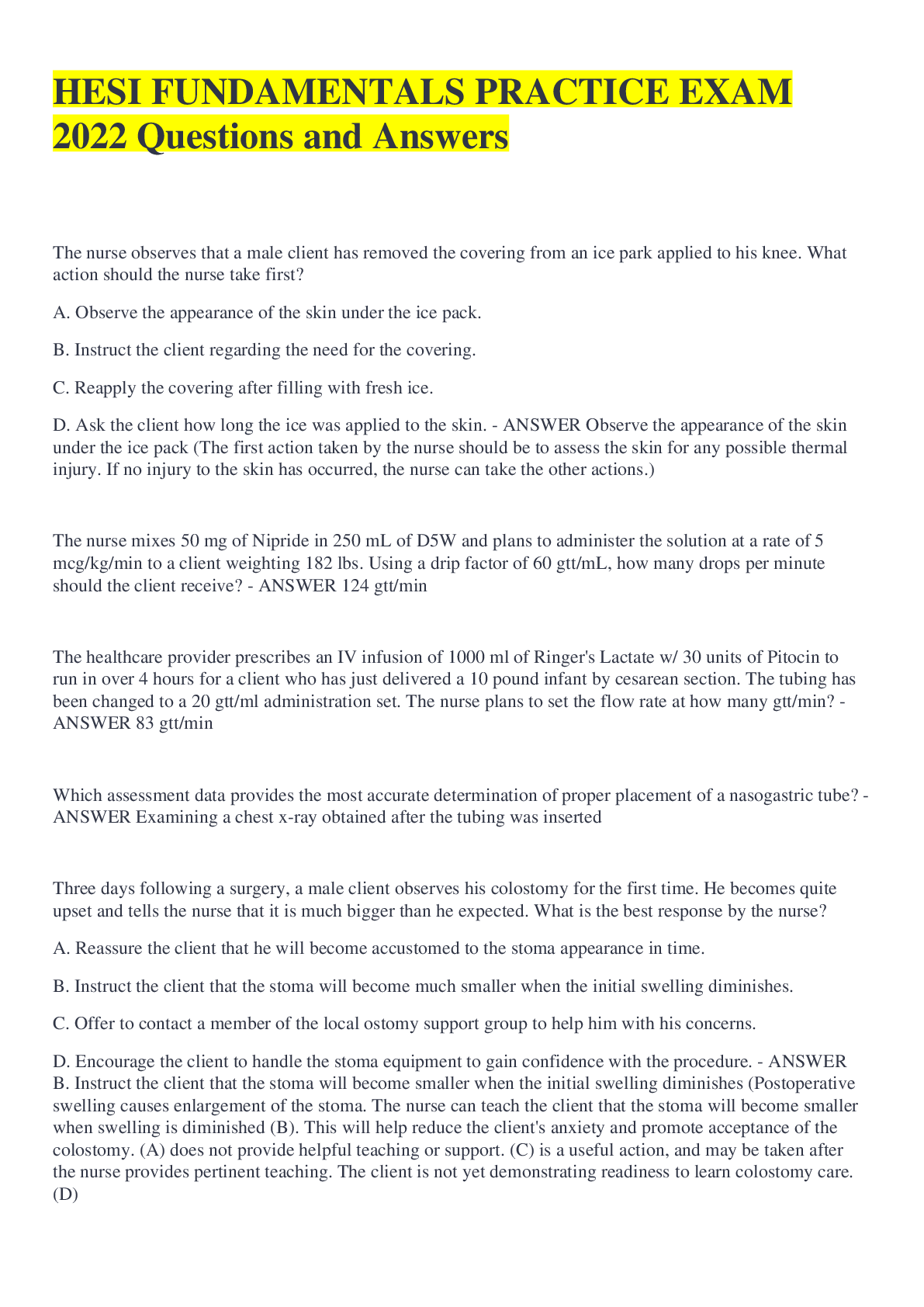
Reviews( 0 )
Document information
Connected school, study & course
About the document
Uploaded On
Oct 03, 2022
Number of pages
21
Written in
Additional information
This document has been written for:
Uploaded
Oct 03, 2022
Downloads
0
Views
253

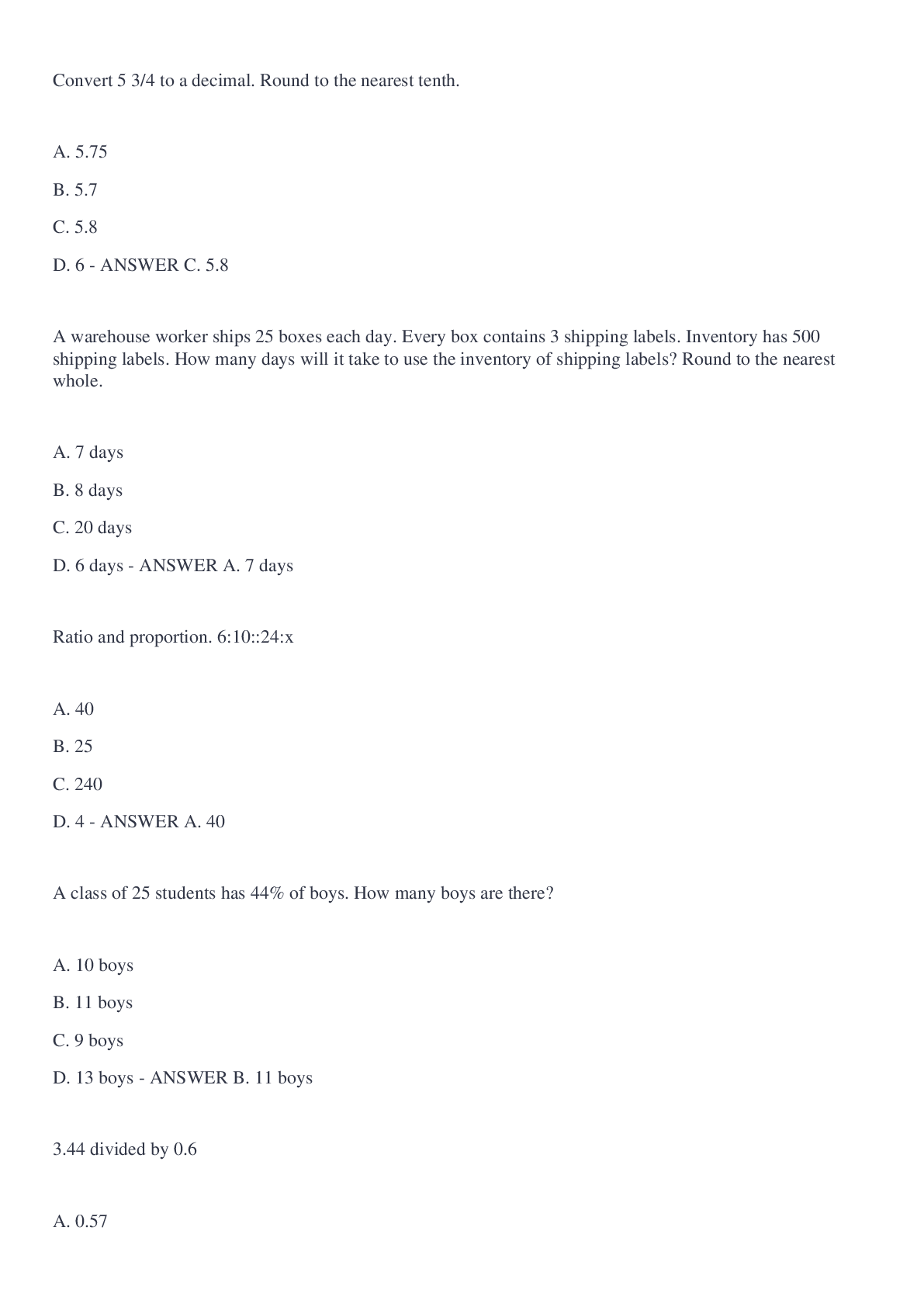

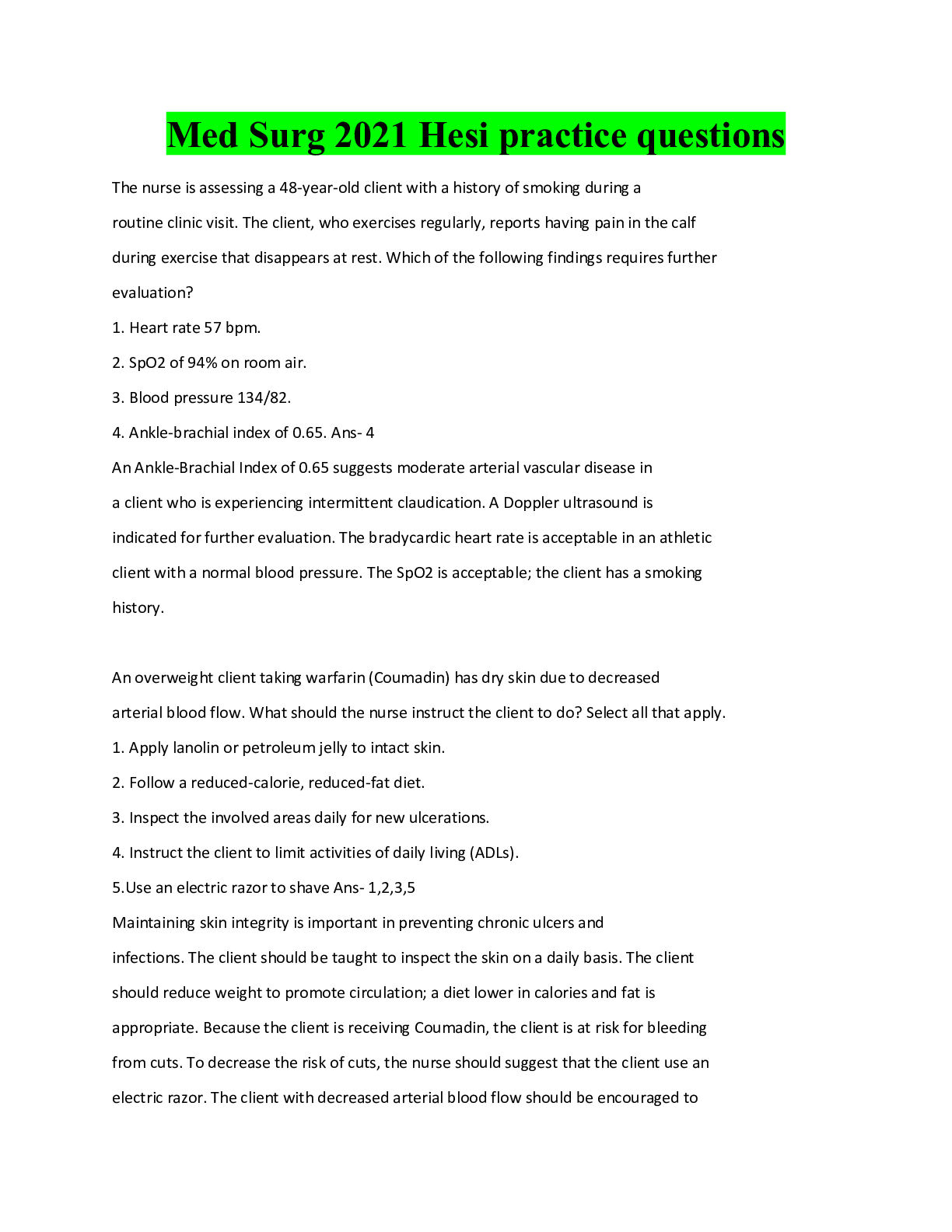



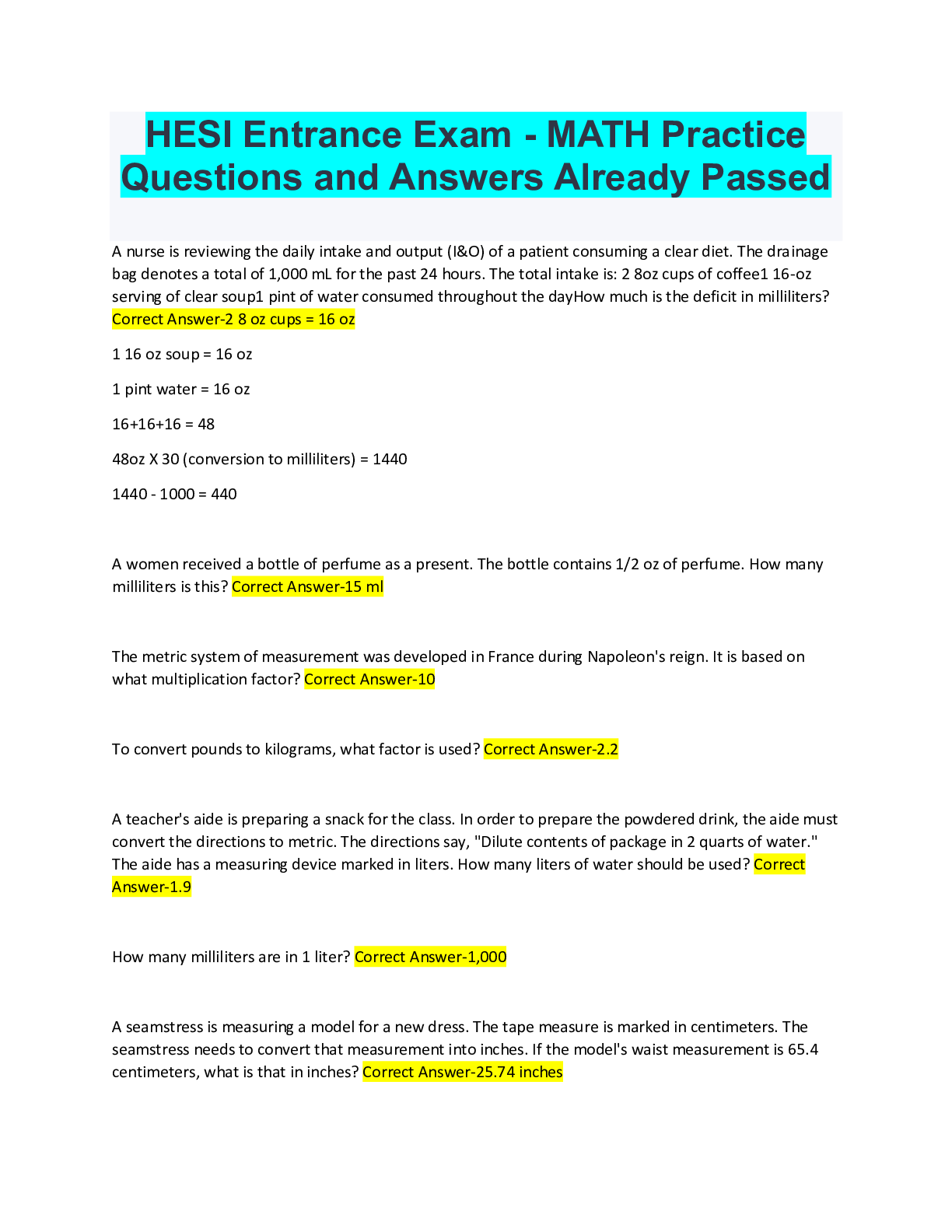

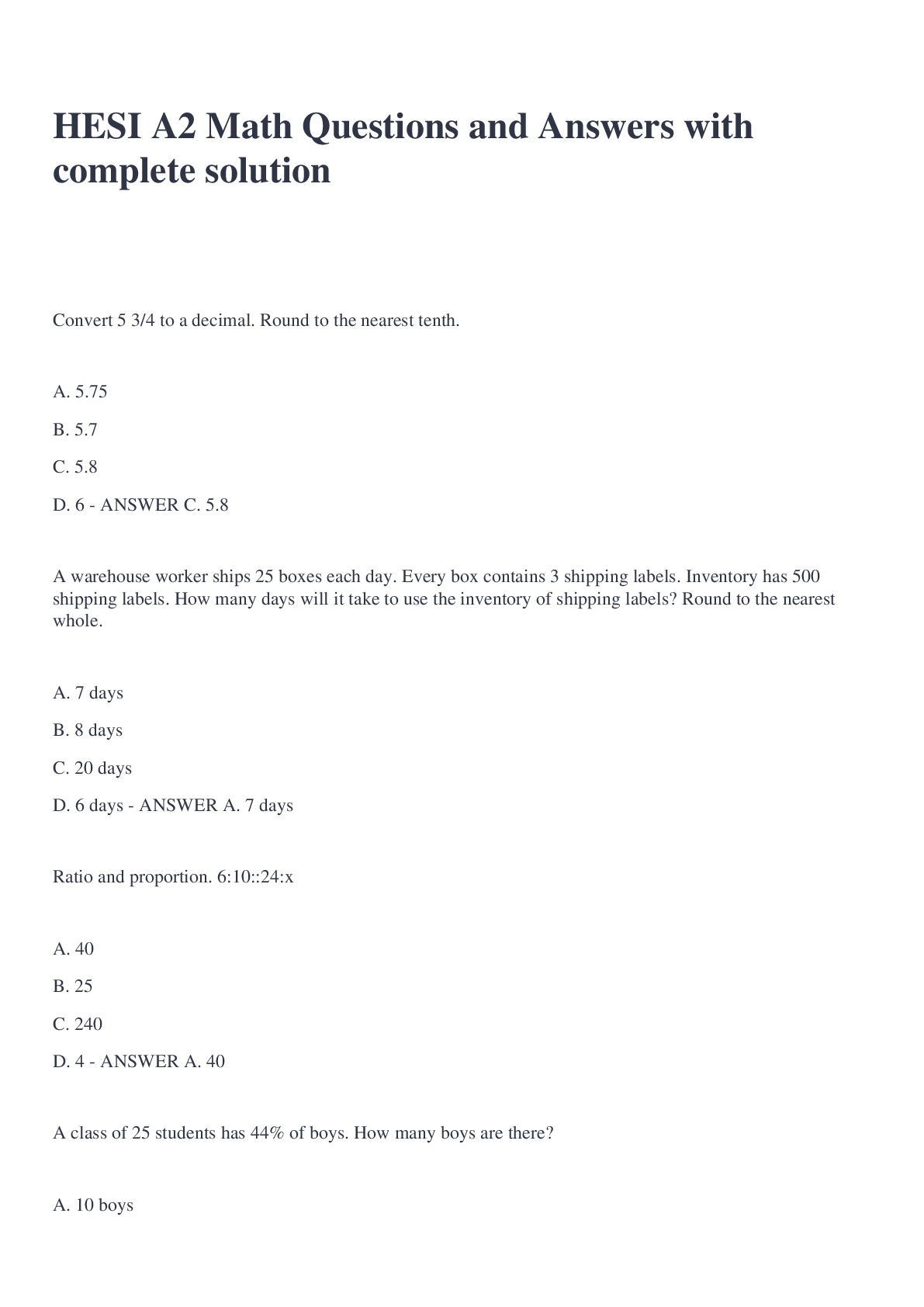

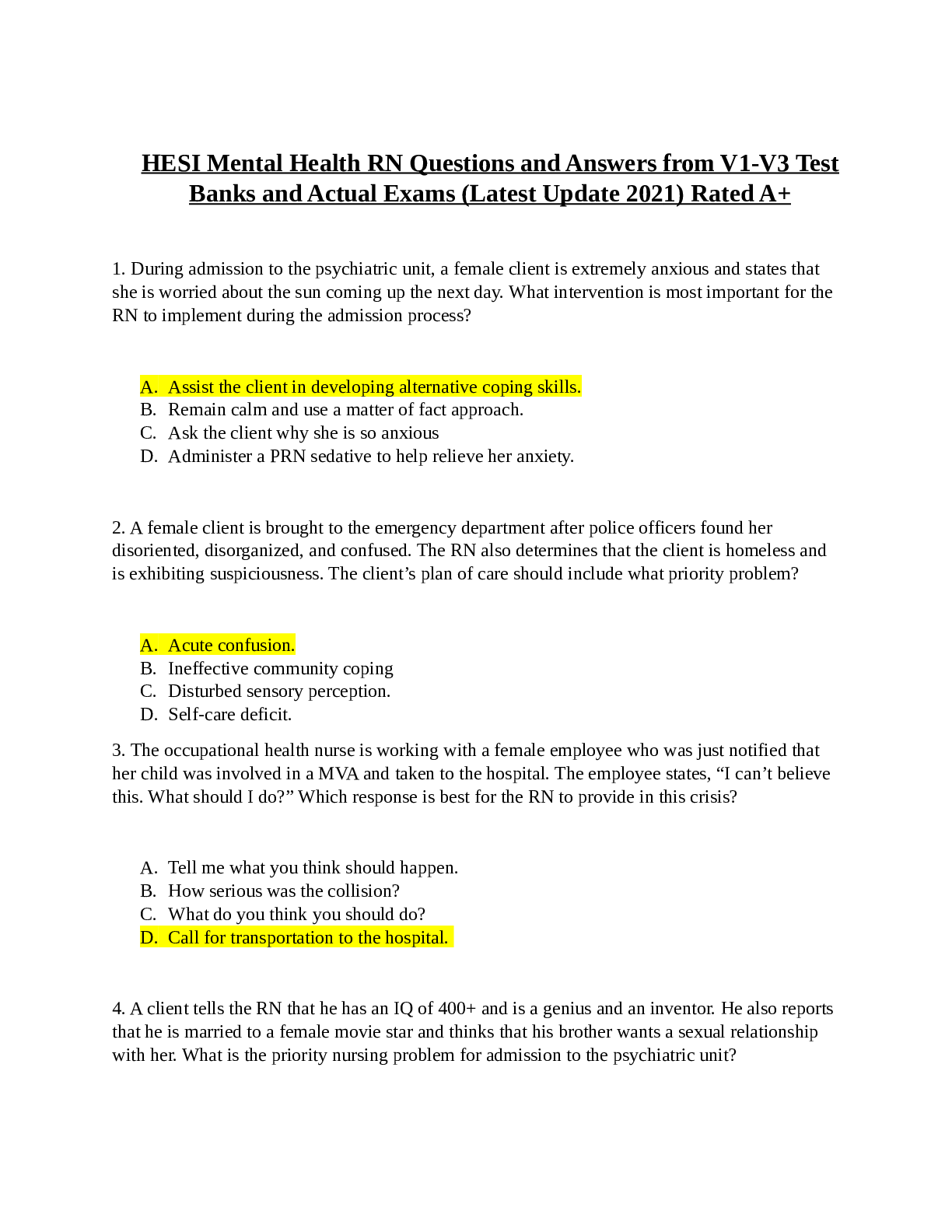





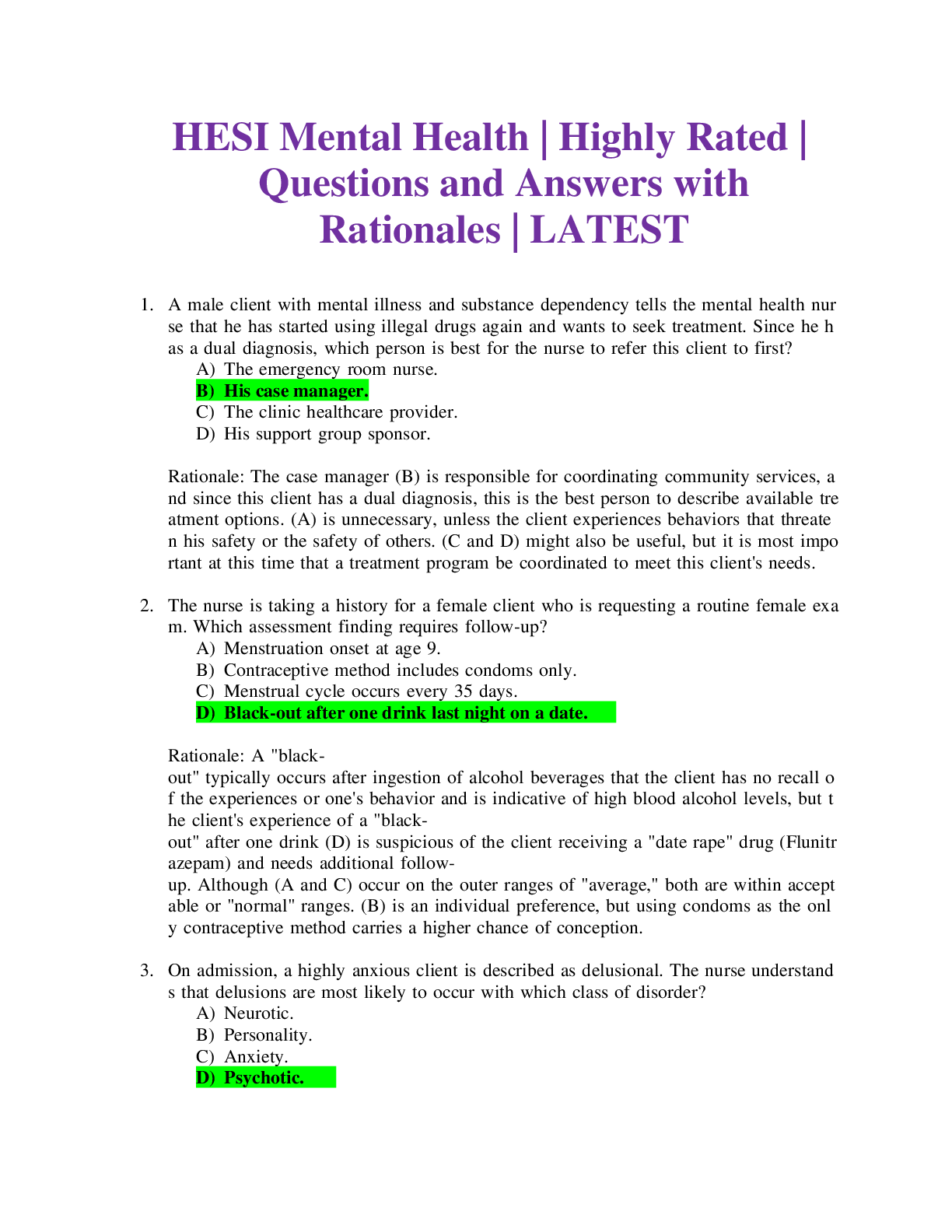

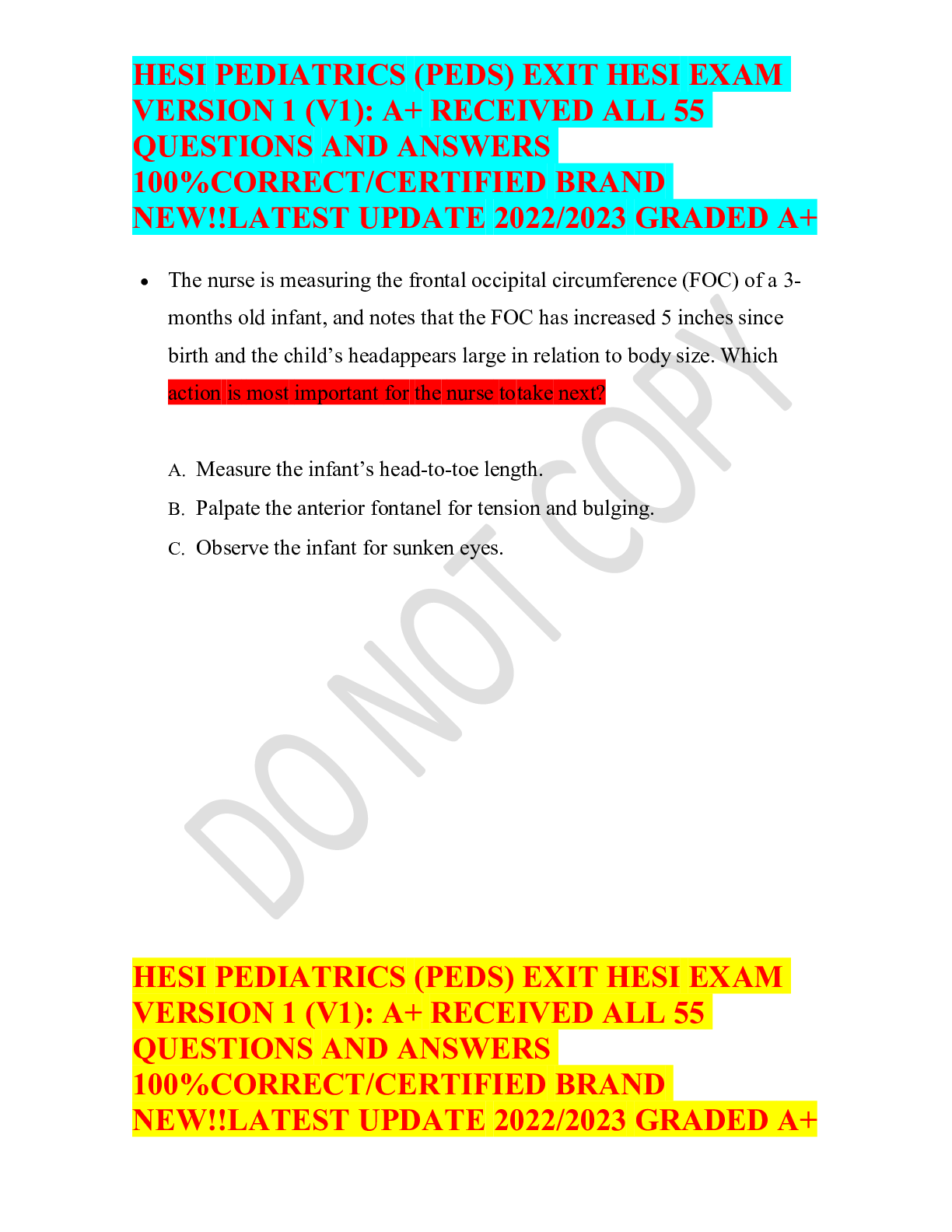
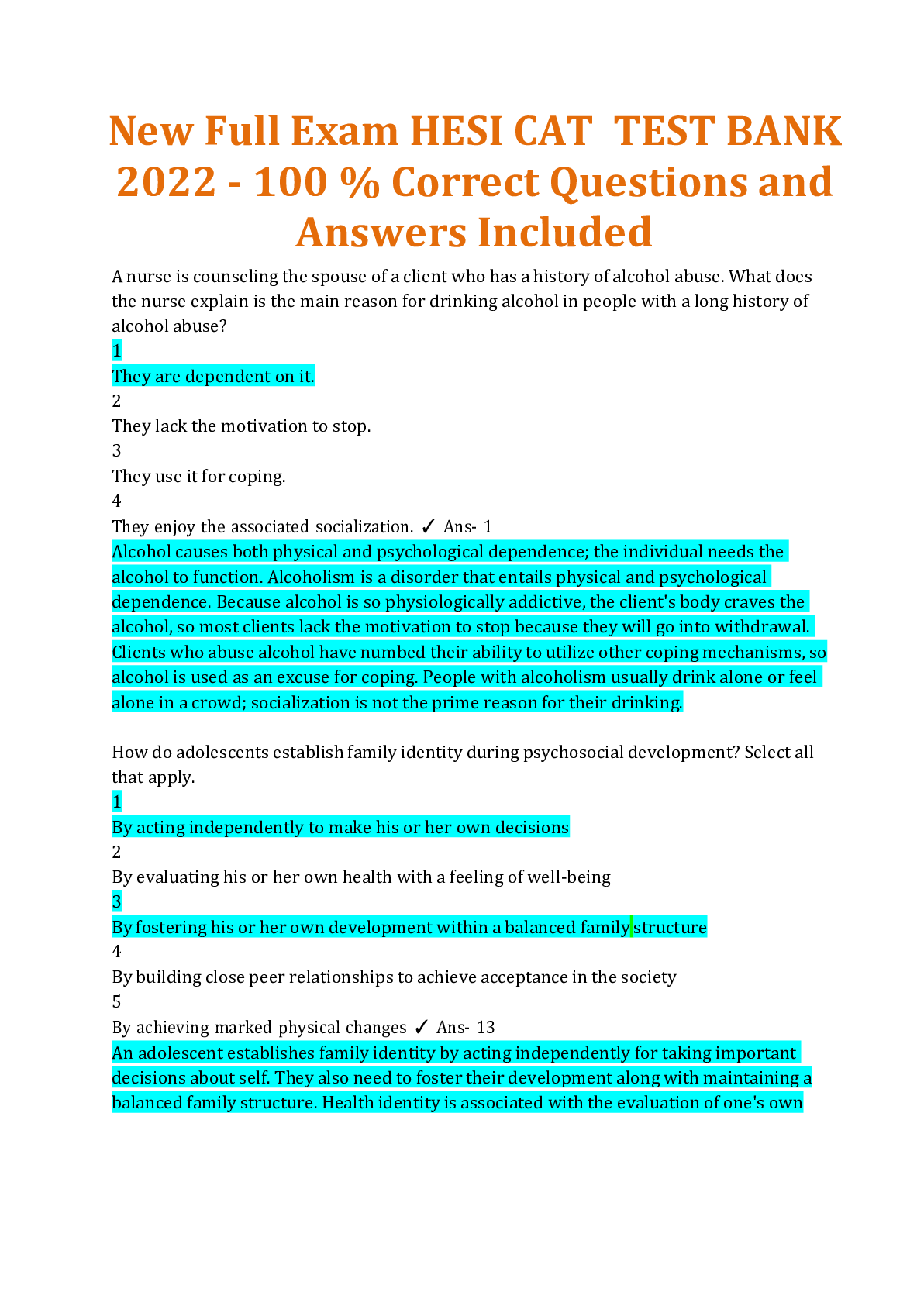
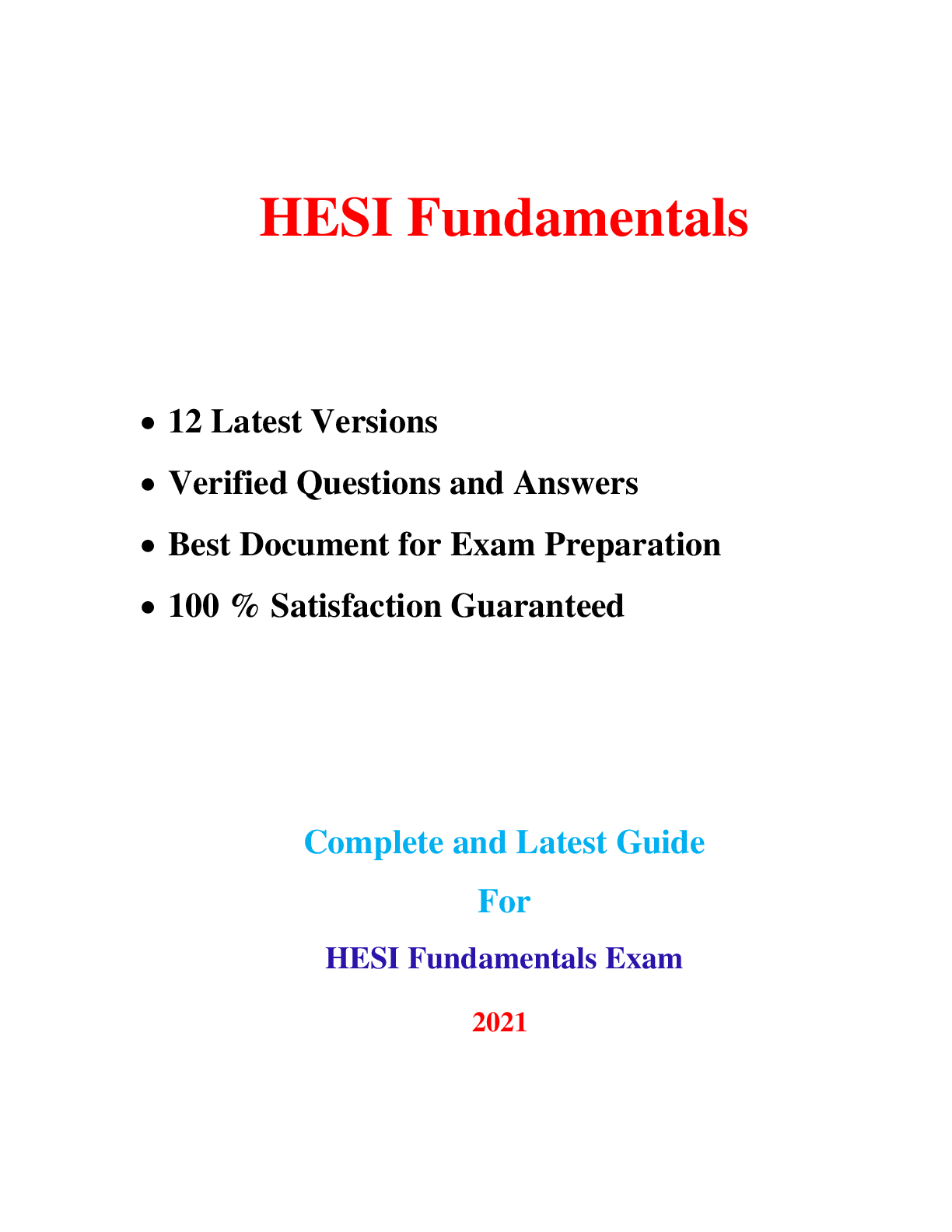

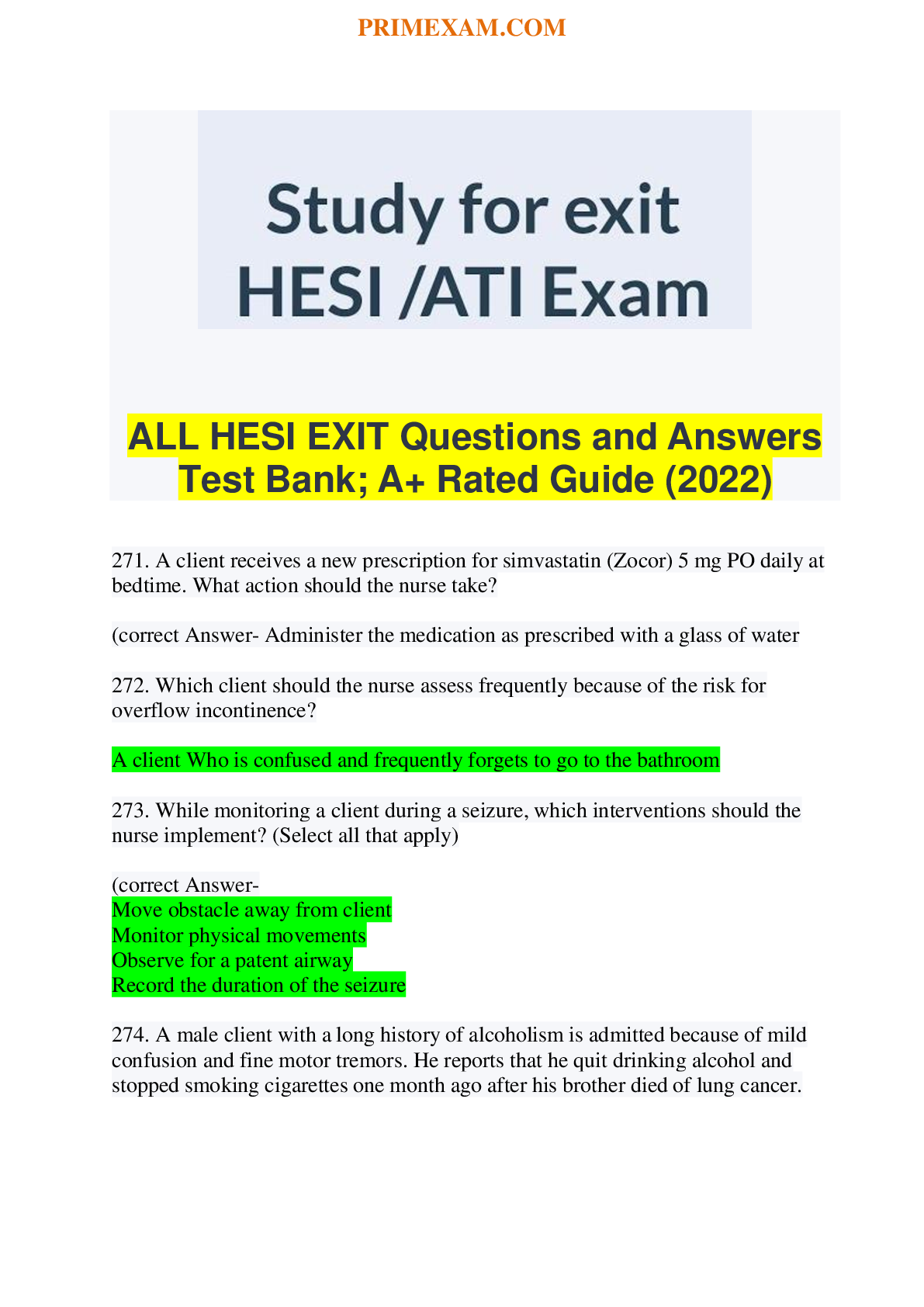
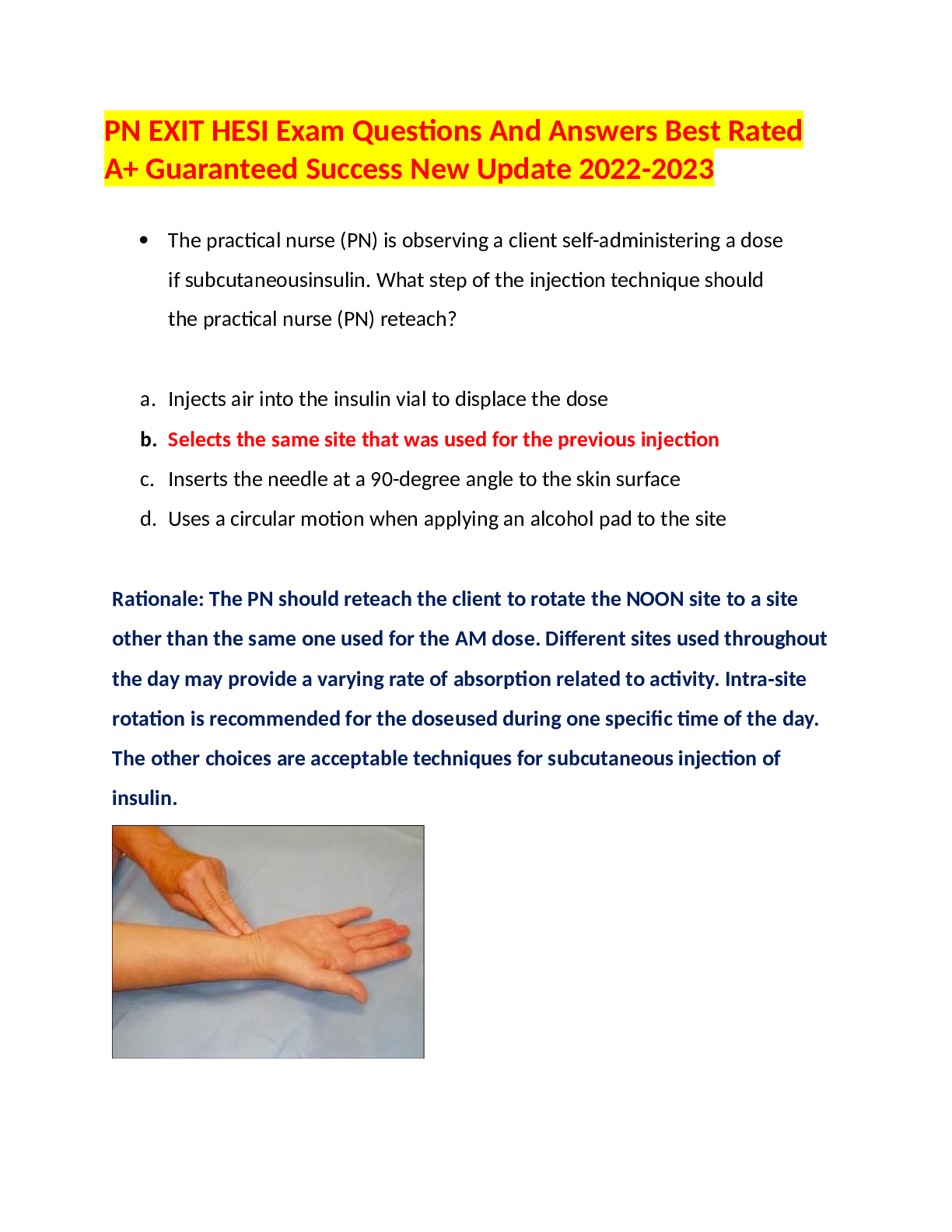
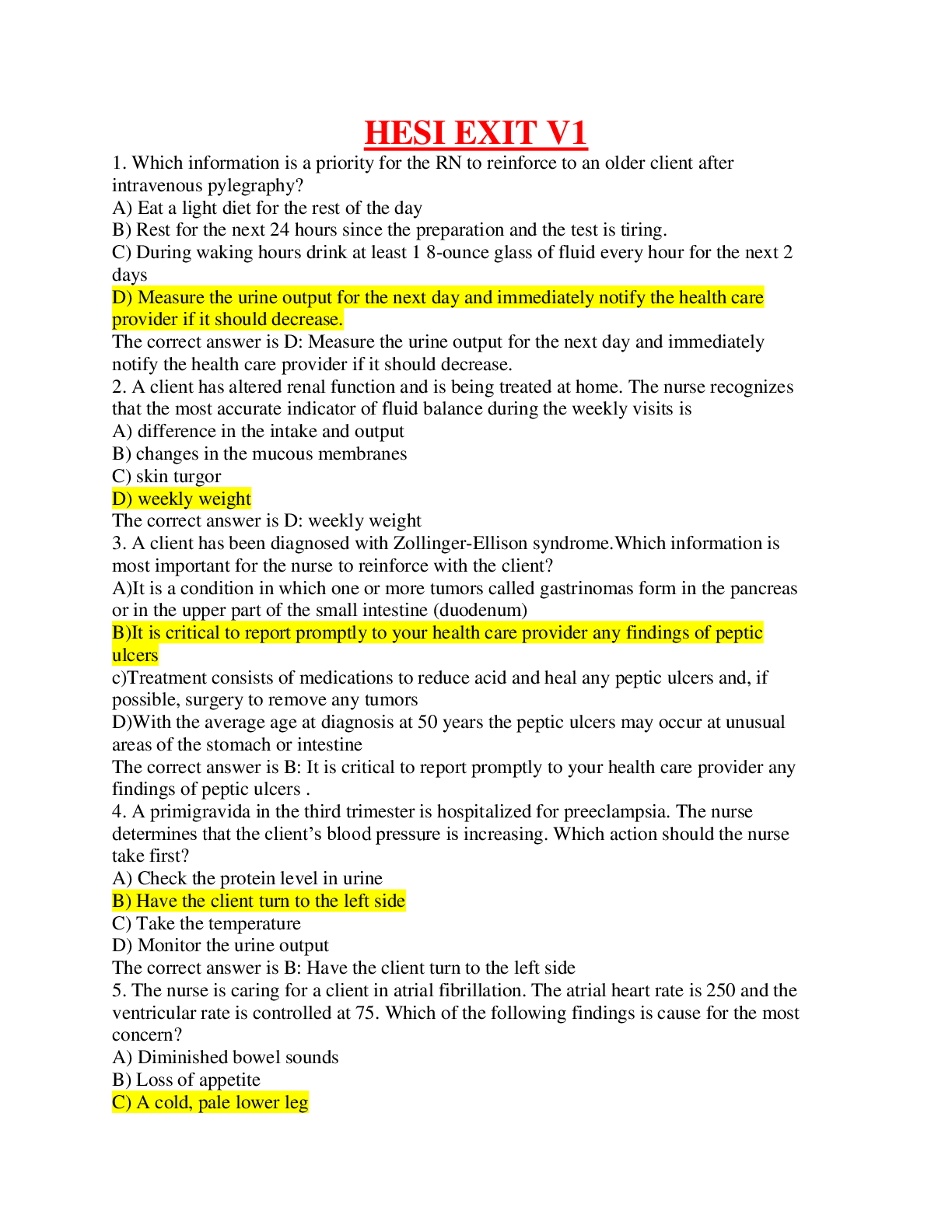

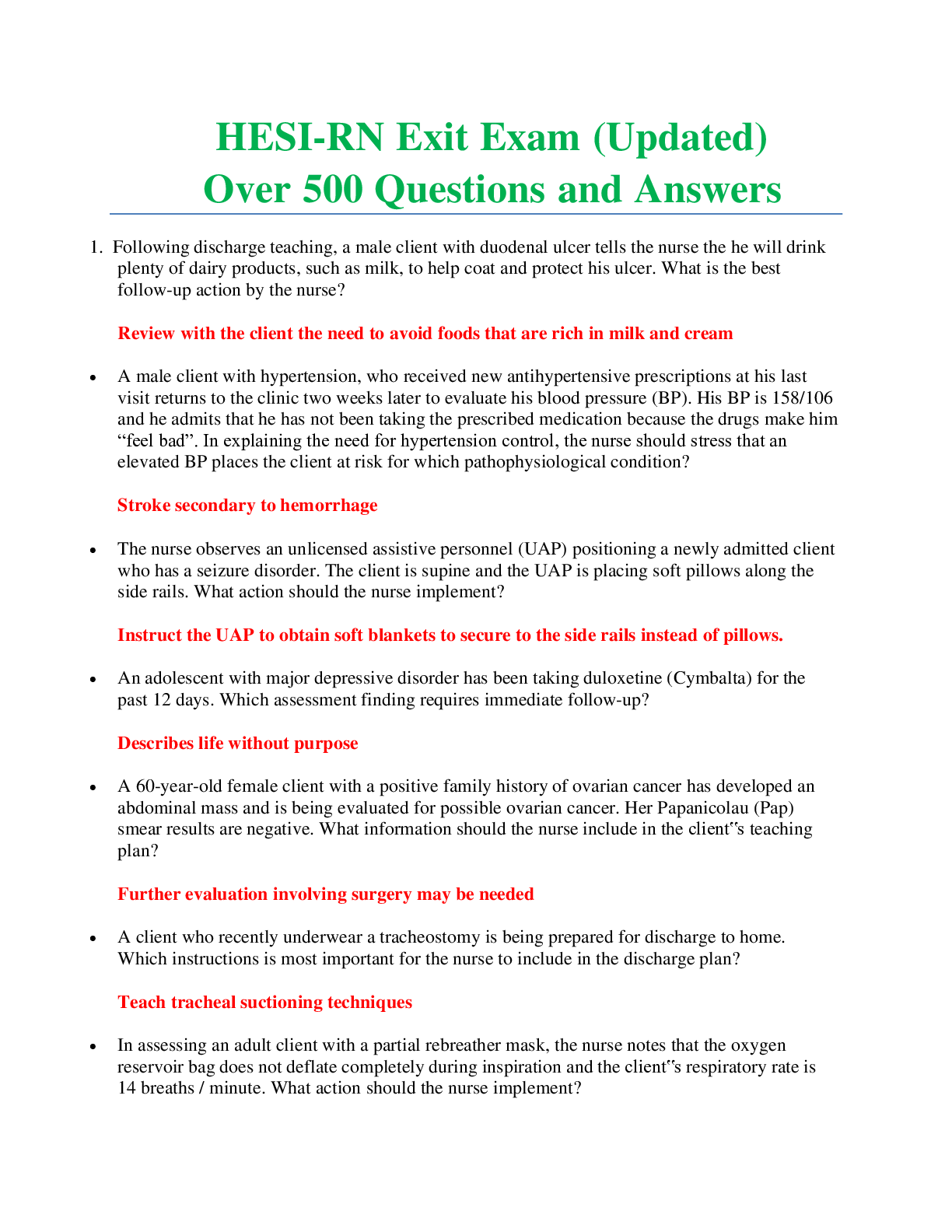
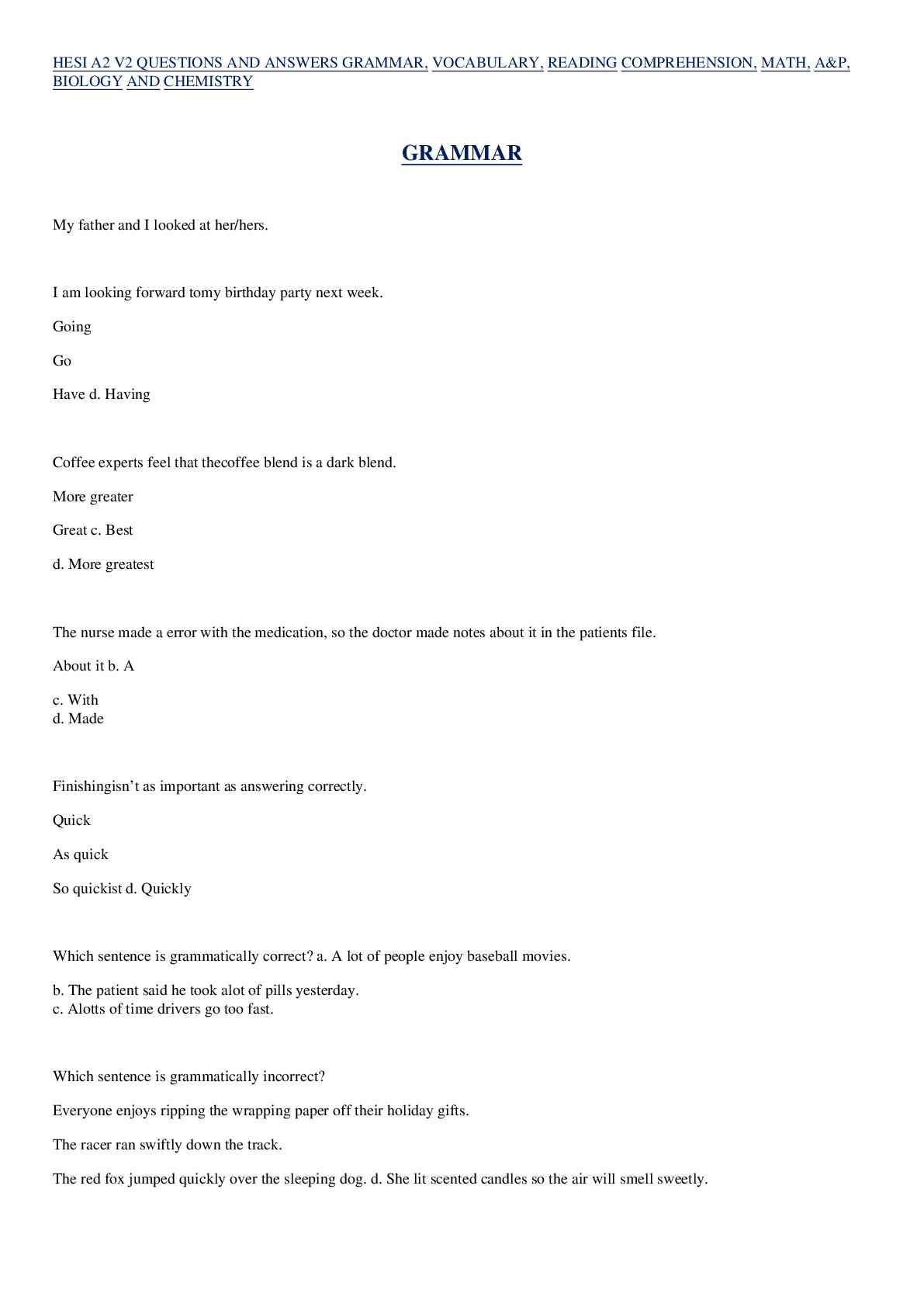

.png)
